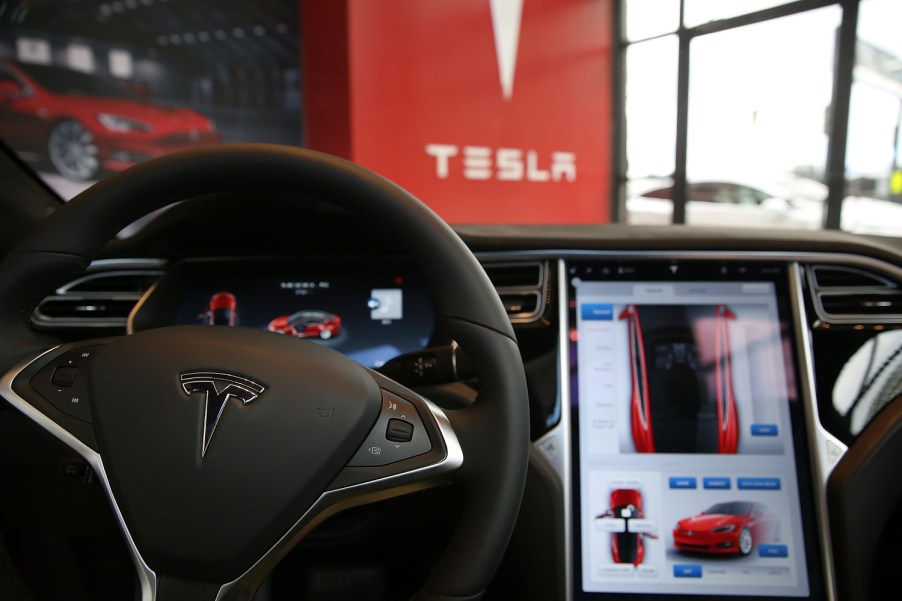
What Is the New Tesla Safety Score System and Why Do People Hate It?
The new Tesla safety score is giving electric vehicle drivers a fun new perk. The internet is full of people poking fun at the recent Safety System put in place to “win” the chance at utilizing Full Self-Driving, but what exactly is going on? How does Tesla determine this score, and why are people upset?
What is the new Tesla Safety Score and why does it matter?

Elon Musk announced that a new software update was coming at the end of last week. Through this update, drivers would be able to see a daily “safety score.” By getting a good score for one week, the owner can request access to Full Self-Driving (FSD) beta software. Seems easy enough, right? Wrong.
According to the Tesla Safety Score release, the score goes from zero to 100 and is based on five “Safety Factors.” These include forward-collision warnings per 1,000 miles and hard braking. The other three factors are aggressive turning, unsafe following, and forced autopilot disengagement. The language used to describe each Safety Factor is…a lot.
There are a variety of stipulations being put on drivers to receive a score to get the opportunity to use Full Self-Driving.
How does anyone determine this new Tesla Safety Score?
Forward Collision Warnings per 1,000 miles are audio and visual alerts that let the driver know a collision is possible. Hard braking is backward acceleration over 0.3g. This is the same as a decrease in the vehicle’s speed larger than 6.7 mph, in one second,” Tesla said. This usually sets off alarm bells when the Tesla electric vehicle experiences backward acceleration of more than 2.2 miles in one second.
Aggressive turning is left or right acceleration over 0.4g. It is incredibly confusing to try and figure out what Tesla means by this. “This is the same as an increase in the vehicle’s speed to the left/right larger than 8.9 mph, in one second.” Unsafe following is basically when you are too close to the car in front. Forced autopilot disengagement happens after three audio or visual warnings occur and are ignored.
If that wasn’t enough, Tesla offers a simple Predicted Collision Frequency (PCF) formula.
| Predicted Collision Frequency (PCF) = 0.682854 | x | 1.014495Forward Collision Warning per 1,000 Miles |
| x | 1.127294Hard Braking | |
| x | 1.019630Aggressive Turning | |
| x | 1.001444Unsafe Following Time | |
| x | 1.317958Forced Autopilot Disengagement |
After that, the Tesla Safety Score is calculated with another easy formula:
Safety Score = 115.382324 – 22.526504 x PCF
Right, so what’s the problem? That seems simple enough to calculate and be on your way.
The new system is quite complicated when the point is to be driving safely
This is similar to the not-very-popular Snapshot device from progressive. It beeped and impacted your insurance rate if drivers stopped short (to avoid a collision) or weaved (to prevent a crash). The point was to lower car insurance rates, but it ended up being a stressful addition without impacting the rates.
If the point of the new Tesla Safety Score is to make the roads safer, it is probably not going to accomplish that. Drivers aggressively turn, brake hard, and follow “too close” to vehicles for various reasons every day. Sometimes situations are unavoidable.
Thus far, the new system has turned into a pseudo-game for Tesla drivers. Drivers have reported that rolling stop signs and running yellow lights seemed to please the system as it avoided certain other harmful factors. It is worth noting that most of the drivers eligible for this system have paid up to $10,000 for Full-Self Driving and waited up to five years to be able to “request” access.
If your score is low, apparently, driving slow is all you need to do. To be fair, the other Tesla’s on the road are probably driving slow in the lane next to you. Elon Musk says the system is still in “Safety Score Beta” mode and will be updating as it collects more data. This should be an excellent weekend for EV watching in a high-traffic area.



